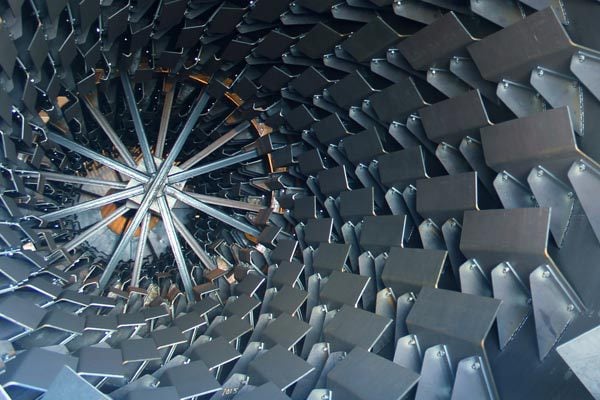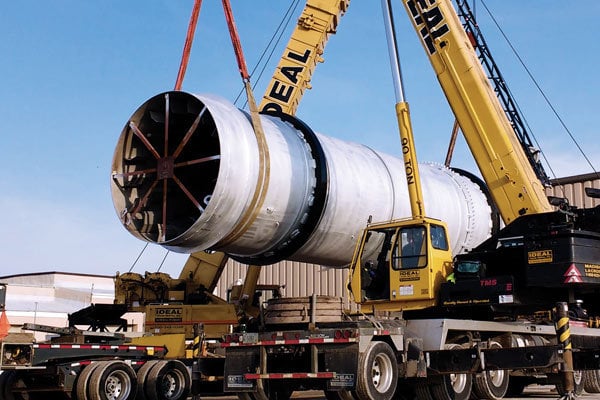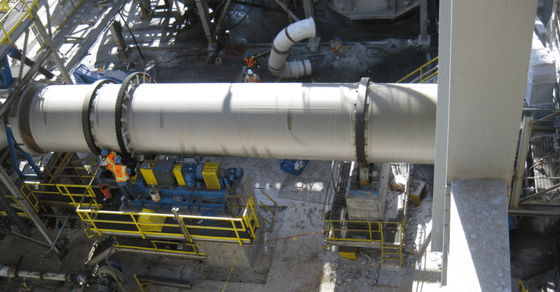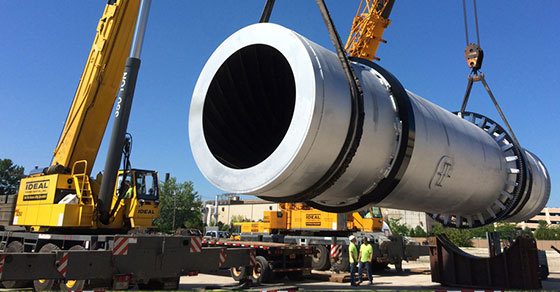Rotary drum dryers are one of the most widely used types of industrial dryers on the market today. Their heavy-duty design, high throughput, long-term reliability, and simple operation has lent them to a wide range of applications in a variety of industrial process settings. They are the dryer of choice for processing fertilizers and soil amendments, animal feeds, minerals and ores, and so much more.
While rotary dryers have a relatively straight-forward design, many questions often arise in considering a rotary drum dryer for a given application, even when the application is well-established. Below are answers to some of the most frequently asked questions surrounding rotary drum dryers.
How does a rotary dryer work?
Rotary dryers consist of a large, rotating drum through which wet solids are passed. As the material moves through the dryer, heat and air are used to remove the desired amount of moisture, with the mode of heating dependent on whether the unit is of the direct or indirect configuration. Most dryers are of the direct design, in which the material is in direct contact with the combustion gases, as this is the most efficient approach to moisture removal.
The material is cascaded in the dryer at carefully controlled temperatures for a predetermined amount of time (referred to as the retention or residence time) to reach the desired final moisture content.
In the case of direct dryers, internal flights, or lifters, are used to pick up material and cascade it through the stream of combustion gases in order to maximize heat transfer efficiency.

Lifting flights inside a FEECO Rotary Dryer
What’s the difference between a direct dryer and an indirect dryer?
The principle difference between a direct rotary drum dryer and an indirect one, is how heat is introduced to the material. Direct dryers rely on convective heat transfer from direct contact between the material being processed and the combustion gases to efficiently dry the material. Conversely, indirect dryers avoid contact between the material and combustion gases, instead relying on heat transfer to occur through the drum shell wall via conduction.
While this approach is less efficient than the direct dryer type, it is an essential processing option when working with materials that must be processed in an inert atmosphere, such as when processing sterile products. The indirect configuration is also chosen when processing ultra-fine materials, as it avoids the risk of solids becoming entrained in the gas flow and ending up in the exhaust gas system.
What types of fuel can rotary dryers accept?
Rotary dryers can accommodate a variety of fuel types, including:
- Fuel oil
- Natural gas/Propane
- Waste heat
- Biogas
- Electricity
- Steam
What does the rotary dryer design process look like?
The design process differs across manufacturers and depends on whether or not the manufacturer relies on standardized designs.
Since rotary dryers are best designed around the specifications of the given application and material to be processed, standardized designs, while less costly and requiring less production time, are inherently not as effective or efficient.
For a truly high-performance rotary dryer, the design process must take into account a wide range of factors such as inlet and outlet moisture, bulk density, heat transfer properties, material consistency and fragility, and more.
The rotary dryer manufacturer will gather the necessary data points and use computer dryer sizing calculations to determine the optimal drum size. Depending on the process goals and application, dryer feasibility testing may be necessary to assess the material’s behavior in the dryer and define the process data necessary for scale-up.
In addition to the process data, the dryer manufacturer will also consider material characteristics and process goals that will influence the design. This might mean selecting different materials of construction, assessing flight design, adding customizations such as knocking systems or trommel screens, and more.
What capacities can a drum dryer handle?
Rotary dryers are capable of handling a wide range of throughput – typically anywhere from 1 TPH – 200 TPH. Rotary dryer capacity is a function of drum size and allowable air velocity.
What information is necessary to design a rotary dryer?
Rotary dryer manufacturers will require the following information to design a rotary dryer:
- Desired throughput
- Inlet and outlet moisture
- Material bulk density
- Inlet and outlet temperature
- Maximum material temperature
- Specific heat
- Particle size (minimum, maximum, and average)
- Desired fuel source
- Higher heating value of fuel source
- Plant elevation
- Ambient air temperature at plant
- Special accommodations (is material explosive, abrasive, etc.)

FEECO Rotary Dryer prepared for shipment
How is a rotary dryer different from a rotary kiln?
Rotary dryers and kilns are similar in design, but are employed for different reasons. Rotary dryers serve to remove moisture from the material, while rotary kilns are intended to cause a chemical reaction or physical change in the material by adding heat. For this reason, rotary kilns are typically operated at higher temperatures than dryers, and therefore, are designed with a higher heat tolerance in mind.
What materials is the dryer constructed from?
Rotary drum dryers can be constructed from a wide range of materials, the choice of which is dependent on the temperatures employed and the characteristics of the material to be processed. Common materials of construction include:
- Carbon steel
- Stainless steel
- Specialty alloys
- Explosion bonded steel
- Abrasion-resistant (AR) steel
The dryer may also utilize multiple materials of construction to meet the needs of the material being processed as well. For example, the sticky nature of some materials may benefit from using polished stainless steel for the inlet section, and carbon steel for the remainder of the drum shell. The polished stainless steel will discourage sticking near the inlet and give material a chance to dry a bit before it reaches the carbon steel, at which point the potential for sticking will be reduced.
What other equipment is needed to support the rotary dryer?
Rotary dryers are not an isolated device, but rather, require a few pieces of support equipment. A complete dryer system consists of:
- Exhaust gas handling (or off-gas handling), where emissions are treated and any particulates are recovered. This includes scrubbers, cyclones, baghouses, electrostatic precipitators (ESP), and more.
- Induced Draft (ID) fan, which draws air through the system to create a negative pressure
- Burner, to produce the combustion reaction between the fuel source
- Dilution air fan to allow for better control of the on gases
- Combustion chamber (optional) to house the combustion reaction
- Control system to control the drying rate
- Material handling equipment, such as conveyors, to carry material to and away from the system
What temperatures do rotary dryers typically operate at?
Rotary drum dryers typically operate at temperatures between 200°F and 2200°F (93 to 1200°C).
Which dryer type is best for my application – rotary drum dryer or fluid bed dryer?
While there is some overlap between these two industrial dryer types, the choice between a rotary dryer and fluid bed dryer is a matter of capabilities. Rotary dryers are best suited for demanding drying applications, such as those found in the mining industry. They are also a better choice when variation in feedstock is common. For more information, see Rotary Dryer or Fluid Bed Dryer.
Can rotary dryers be automated?
Yes: Rotary dryers are easily automated. Depending on the manufacturer, automation capabilities may differ. FEECO has partnered with Rockwell Automation to offer dryer automation capable of monitoring, collecting, and trending various data points such as current (amps), fan speed, feed rate, fuel usage, gas sampling & analysis, horsepower, system pressures, temperatures, and more.

FEECO Rotary Drum Dryer installed at customer site
Are rotary dryer specifications customizable?
Yes. In fact, FEECO recommends rotary dryers be customized for the application as much as possible, as this will produce the most efficient and reliable drying solution.
Several aspects of the rotary dryer can be customized, including materials of construction, flight design and pattern, sizing, support equipment, and more.
Conclusion
Rotary drum dryers offer efficient, reliable industrial drying; their high capacity, robust build, and flexible design makes them a fit for nearly any application.
FEECO is the leading provider of custom rotary dryers, with hundreds of installations around the world. Our rotary dryers are built to the highest quality standards and are engineered around the unique characteristics of the material to be processed for an optimal drying solution. For more information on our dryers, contact us today!

